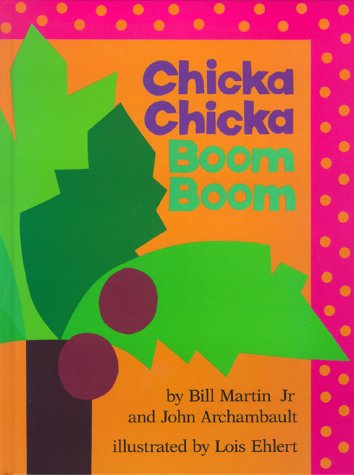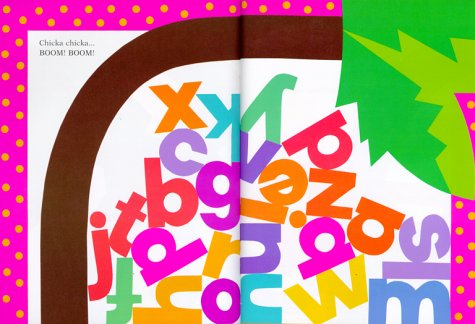"Chicka Chicka Boom Boom"
Authors: Bill Martin Jr and John Archambault
Illustrator: Lois Ehlert
Publisher: Simon & Schuster Children's Publishing
ISBN: 067167949X
Recently, I have been reading many picture books to children that in my class. It is so exciting to see the expression on their faces when I tell them that it’s story time. Picture books are a wonderful way for children to see a story that contains both pictures and text. These pictures and text can help children gain knowledge and help them learn to read. Many children get excited when they get to see their favorite picture book being read. One picture book that many of my children seem to like I work is “Chicka Chicka Boom Boom.” “Chicka Chicka Boom Boom” is an alphabet book that was written by Bill Martin Jr and John Archambault and illustrated by Lois Ehlert.
“Chicka Chicka Boom Boom” is an entertaining alphabet book. It starts with A telling B and B telling C to meet “at the top of the coconut tree.” The letters are in alphabetical order as they begin to climb the coconut tree. The letters are really enjoying themselves but as the more climb up to the tree, the tree begins to bend over. It bends and bends more over until Chicka Chicka. BOOM! BOOM! all the letters fall down. The letters get untangled and the letters start climbing up the tree again. This seems to want children to read it over and over again.
As discussed in class, this picture book offers rhyme, rhythm and repetition. This story has catching rhyming text and energetic pictures that makes this a favorite to many. Not only does this book have rhyming it also shows repetition of the words “Chicka Chicka, Boom Boom” These four words positively invite children to sing along with the story. I know from personal experience that when I do this story with children they love when I say, Chicka, Chicka, and then they say BOOM BOOM! To go along with the text the illustrations are what makes this story come to life. The illustrations are collages that are full of colors and movement that complement and extend the story. What I also enjoy is lower base letters are the children and the upper case letters are the adults
Children of all ages will enjoy the rhythm, story, and illustrations. The older the children, the more they will want to chant along. Children especially enjoy identifying the letters of the alphabet for you. After reading this story the children and I developed a poster board with the rhyming alphabet. Every time a child went near it they would say, Chicka Chicka Boom Boom. This book is a great tool for children to recognize the letter in the alphabet and enjoy an entertaining story!


In reading along with your blog entry for this week, anyone can plainly see the care and dedication that you put into engaging the children with whom you work. I both applaud and admire how you were able to skillfully integrate your enthusiasm for Chicka Chicka Boom! Boom! with the concepts and themes we learned about in our class from this past Monday. Oftentimes, we as adults have the tendency to overlook the value in truly capturing our students' attention with devices as simple as a well thought out and entertaining picture book.
ReplyDeleteI also noticed that in addition to your reference to the use of rhyme, rhythm, and repetition, you included the same type of interactive experience promoted by Professor Berry during some of her read alouds. Having seen what an effective tool this has been for learning and environment building at our own level, I'm glad to see that it has an even better effect on younger students.
I look forward to employing these methods with a class myself, and am intrigued by the possibility of combining activities such as these with other projects, as you did by developing a rhyming alphabet poster. In essence, you are creating a sort of compound repetition mechanism, wherein the students are performing an activity involving a repetitive action, but are also brought back to the experience on a personal level at the sight of your artwork displayed in the room.
These multiple forms of stimuli are what will ultimately allow the children whose lives we touch to become the well-rounded, competent, and productive individuals that will one day impart their own version of these experiences to the next generation.
Marisa-I agree with John. From reading your entry, I can clearly see that you are passionate about educating children. I find alphabet books so interesting. Authors are able to take something so classic and put their own spin on it.
ReplyDeleteIt's so important to engage children from the start of any lesson or discussion. The title of this book alone had me at hello. And after reading your thoughts, I will definitely add this to my library.